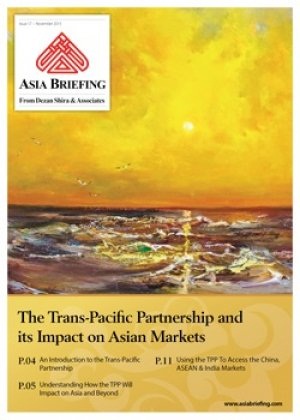Understanding Financial Integration in ASEAN
 By: Dezan Shira & Associates
By: Dezan Shira & Associates
Editor: Ellena Brunetti
Established in late 2015, the ASEAN Economic Community represents a significant achievement in a decade’s long process towards regional financial integration. Although far from complete, integration of finance throughout the region plays a key role in the financial sector’s continued development, facilitating greater access to insurance, capital markets, and banking.
Improved access to these services not only improves allocation efficiency and increases economic growth, but it concurrently lowers the cost of capital. However, even as progress is made in harmonizing the sector, liberalization of financial services remains objectively more complex than other areas of liberalization such as reduction of tariff rates on particular goods, and thus requires more time to implement.
To gain a more in depth understanding of ASEAN’s efforts to integrate financial services, it is important to understand the progress that the region has seen in recent years as well as the continued efforts and existing challenges faced by governments within the region in 2016.
 RELATED: Pre Investment and Market Entry Advisory from Dezan Shira & Associates
RELATED: Pre Investment and Market Entry Advisory from Dezan Shira & Associates
Progressing Financial Integration in ASEAN
The push for financial integration in ASEAN has been a drawn out process that has been on the regional agenda since the Asian financial crisis in 1997. The following are some of the most important integration milestones accomplished in recent years:
2003 – The Roadmap for Monetary and Financial Integration in ASEAN: agreed upon by ASEAN’s finance ministers, the roadmap established a path towards integration of financial markets, and helped to ensure the liberalization of financial services and sustainable development of capital markets.
2007 – AEC Blueprint: ASEAN leaders declare their intention to establish an Economic Community (AEC) by 2015 in order to facilitate greater trade and investment flows in the region. To do so, they articulate plans to liberalize trade and services at a regional scale, including financial services, by interlinking the financial systems of the member states and liberalizing capital account regimes.
Specific goals set out under the blueprint include:
- Progressive removal of restrictions on intra regional provision of financial services
- Harmonization of regional capital market standards
- Liberalization of capital accounts through the dismantling of account restrictions
- Capital market development, by building capacity and infrastructure for development of ASEAN capital markets
- Harmonization of payments and settlements systems
- The mutual recognition of qualification of financial sector professionals
For a full text of the blueprint click here
2011 – ASEAN Financial Integration Framework: provides a general approach to the liberalization and integration initiatives under the AEC. This framework aimed at having a semi-integrated financial region by 2020, in which each member state would be allowed to define its own milestones and timelines to achieve the common end goal of financial integration. To do so, the main objectives that were to be reached by the member states were the following:
- Removing restrictions to the intra-ASEAN provision of financial services by ASEAN financial institutions
- Building capacity and infrastructure to develop and integrate the ASEAN capital markets
- Liberalizing the flow of capital across the ASEAN region
- Harmonizing payments and settlements systems
- Strengthen capacity building, regional financing arrangements, and regional surveillance
2013 – Summary Report “The Road to ASEAN Financial Integration – A Combined Study on Assessing the Financial Landscape and Formulating Milestones for Monetary and Financial Integration in ASEAN” : launched by the Central Bank Governors from ASEAN member states, the report acts as an important reference for ASEAN to further guide its financial integration process.
For a full text of the report click here
![]() RELATED: Singapore Overtakes Hong Kong as Asia’s Top Financial Hub
RELATED: Singapore Overtakes Hong Kong as Asia’s Top Financial Hub
The Future of the Integration Process
Insurance
In an area of the world particularly vulnerable to natural disasters, insurance plays a critical role in providing safeguards against the risk of economic loss. While individual countries have implemented a variety of measures to mitigate these risks, the lack of uniform coverage creates uncertainty for potential investors.
In an effort to combat confusion, leaders have passed the ASEAN Insurance Integration Framework (AIIF). This is set to improve the cross border supply of Marine, Aviation and Goods in International Transit insurance. Signed in 2015, the agreement is set to come into effect during the later half of 2016.
The next areas in need of liberalization are catastrophe insurance and reinsurance. These will encourage individuals and firms to obtain personal insurance, enabling them to cushion the risks of their day-to-day operations. This change should help in lowering the cost of insuring cross border business risks and help to increase intra-ASEAN trade.
Capital Markets
In capital markets, ASEAN has made good progress on integration. Starting with Thailand, Malaysia, and Singapore, concrete measures have been put in place to broaden market linkages and harmonize disclosure requirements through the introduction of ASEAN Disclosure Standards.
For investors, the ASEAN Trading Link among Thailand, Malaysia, and Singapore provides a single gateway to all three exchanges. Investors can henceforth buy shares through their local stockbroker in the other two markets. In the same way, issuers can sell their shares in the three different markets without having to follow three different procedures. Another improvement is the launching of the ASEAN Collective Investment Scheme Framework, which permits fund managers authorized to manage a fund in one country to be able to conduct a cross border offering of funds.
However, it should be noted that some of the ASEAN capital markets are often small and not developed enough, offering a limited range of products and services, and thus generally illiquid, which leads to markets remaining highly vulnerable to external shocks. The further liberalization of ASEAN markets should however allow them to become more liquid and, as a result, more stable.
Banking
As part of the ASEAN Financial Integration Framework, central bank governors of ASEAN member states created the ASEAN Banking Integration Framework (ABIF) in December of 2014. The agreement permits banks meeting certain criteria to be classified as “Qualified ASEAN Banks” and provides these institutions with widened access to other ASEAN markets.
As a prerequisite to tapping the benefits of their “Qualified” status, banks must ensure that bilateral agreements allowing greater access to qualified ASEAN banks have been concluded between their home market and countries in which they wish to set up operations.
In the event that an agreement is in place, banks will be afforded the same treatment as local banks in the ASEAN country in which they are established. Thanks to this system, a smaller bank from an ASEAN country will have the opportunity to expand its activities in another ASEAN country. This system will provide significant benefits to small and medium businesses looking to establish themselves within the region, as their domestic banks will be more capable of providing financial support if they can also operate beyond their borders.
While significant progress is on the horizon, ASEAN’s banking integration will follow a later timeline that other areas of financial integration and will only take place in 2020. Furthermore, for banking integration to be successfully launched, each ASEAN country will first need to consolidate their banks in order to safeguard the region against the systemic risks that could otherwise occur.
Maximizing Opportunities in ASEAN
In the near to medium term, ASEAN’s pace of financial integration will remain largely disjointed and increasingly reliant upon commitment from individual ASEAN member states. As the majority of simplistic integration procedures have been completed, the future of the integration process will likely be characterized by mounting concessions on the part of individual members. Further complicating this process, ASEAN’s consensus approach to decision making will prevent the region from adopting harmonized standards in the face of minority opposition.
While challenges are substantial, investors able to foresee policy consensus will be in a perfect position to capitalize on what many have projected to be one of the fastest growing regions of 2016. With a pan ASEAN team and over twenty years of experience of experience in Asia at large, Dezan Shira & Associates is perfectly positioned to assist companies in their efforts to unravel ASEAN’s current policies regarding financial integration and to highlight opportunities for investment. For more information on our services please contact us at singapore@dezshira.com or visit us online at www.dezshira.com
|
Asia Briefing Ltd. is a subsidiary of Dezan Shira & Associates. Dezan Shira is a specialist foreign direct investment practice, providing corporate establishment, business advisory, tax advisory and compliance, accounting, payroll, due diligence and financial review services to multinationals investing in China, Hong Kong, India, Vietnam, Singapore and the rest of ASEAN. For further information, please email asean@dezshira.com or visit www.dezshira.com. Stay up to date with the latest business and investment trends in Asia by subscribing to our complimentary update service featuring news, commentary and regulatory insight. |
Annual Audit and Compliance in ASEAN
For the first issue of our ASEAN Briefing Magazine, we look at the different audit and compliance regulations of five of the main economies in ASEAN. We firstly focus on the accounting standards, filing processes, and requirements for Indonesia, Malaysia, Thailand and the Philippines. We then provide similar information on Singapore, and offer a closer examination of the city-state’s generous audit exemptions for small-and-medium sized enterprises.
 The Trans-Pacific Partnership and its Impact on Asian Markets
The Trans-Pacific Partnership and its Impact on Asian Markets
The United States backed Trans-Pacific Partnership Agreement (TPP) includes six Asian economies – Australia, Brunei, Japan, Malaysia, Singapore and Vietnam, while Indonesia has expressed a keen willingness to join. However, the agreement’s potential impact will affect many others, not least of all China. In this issue of Asia Briefing magazine, we examine where the TPP agreement stands right now, look at the potential impact of the participating nations, as well as examine how it will affect Asian economies that have not been included.
 An Introduction to Tax Treaties Throughout Asia
An Introduction to Tax Treaties Throughout Asia
In this issue of Asia Briefing Magazine, we take a look at the various types of trade and tax treaties that exist between Asian nations. These include bilateral investment treaties, double tax treaties and free trade agreements – all of which directly affect businesses operating in Asia.









